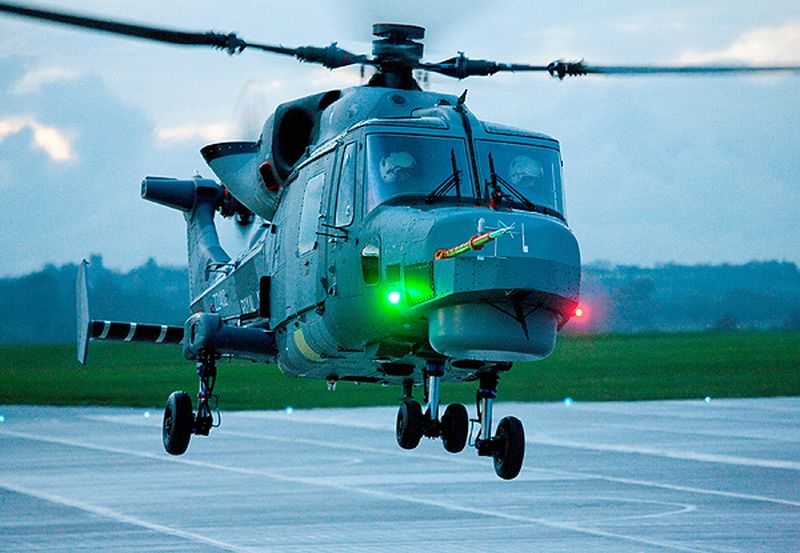AgustaWestland, a Finmeccanica company, is pleased to announce that the first production AW159 helicopter will be making its first appearance at the Paris Air Show.
Sixty two AW159s have been ordered by the UK Ministry of Defence for the Army and Royal Navy to fulfil both over land and maritime missions with a common platform.
The AW159, whilst building on the pedigree of the current Lynx, is a new 6-tonne multi-role military helicopter featuring a new marinised airframe, all new avionics, new mission sensors and new generation weapon systems.
The AW159 programme has achieved several major milestones so far in 2011 and continues on time and on budget ready to deliver the first aircraft to the UK Ministry of Defence at the end of 2011. The first production aircraft performed its maiden flight on 20th April 2011 at AgustaWestland’s Yeovil facility and a further six production aircraft are now undergoing final assembly on a new state-of–art assembly line.
The three trials aircraft which first flew in November 2009, October 2010 and November 2010 have now completed over 250 flying hours of a 600 hour integrated flight test programme. The three aircraft are set to undertake a number of proving trials in the coming months.
Later this month aircraft #1 will start hot and high trials in the USA and aircraft #3 will undertake Shipborne Helicopter Operating Limit (SHOL) trials in October 2011. Aircraft #2s flight testing has been focusing on the successful integration of the avionics and mission sensors and recently completed chaff and flare firing trials.
AgustaWestland will start to train initial British Army pilots in early 2012 and the aircraft is set to become fully operational with the Army in 2014 and the Royal Navy in 2015. The British Army’s AW159 Lynx Wildcat will perform a wide range of tasks on the battlefield including reconnaissance, command and control, transportation of troops and materiel, and the provision of force protection.
The Royal Navy variant will provide an agile maritime capability providing anti-surface warfare capability and force protection and will operate in support of amphibious operations and be an important element in defending ships against surface threats. There will be a high degree of commonality between the Army and Royal Navy helicopters that will mean that an aircraft can switch roles easily, principally through the changing of role equipment.
In March 2011 AgustaWestland signed a contract with the UK Ministry of Defence (MoD) to design and develop an integrated training solution for the AW159 Lynx Wildcat helicopter which includes the building and equipping of a state-of-the-art training centre at RNAS Yeovilton in South West England, alongside Royal Navy and British Army AW159 Lynx Wildcat squadrons.
The facility will provide training courses for Army aircrew and maintainers starting in January 2013, with training for Royal Navy aircrew and maintainers starting in January 2014. The Lynx Wildcat Training Centre will be equipped to provide air crew and maintainer training using a wide range of synthetic training technology including two Full Mission Simulators (FMS), Flight Training Device (FTD) and Cockpit Procedures Trainer (CPT).
All devices will be capable of delivering Army or Royal Navy conversion and mission training. Each of the Full Mission Simulators has six degrees of freedom to provide the acceleration sensations associated with helicopter flying together with a visual system that complies with JAR-FSTD-H Level D, to give highly realistic and cost effective training. The maintenance training facility will be equipped with a suite of synthetic training devices covering the aircrafts mechanical, avionic and weapon systems.
The training centre will also contain a suite of briefing rooms, integrated electronic classrooms and a learning management system will be operational and providing training for the Army from early 2013 and for Royal Navy from early 2014. AgustaWestland is also working with the UK MoD to develop an Integrated Operational Support (IOS) solution to provide cost effective through life support for the entire fleet of 62 aircraft.
The AW159 programme for the UK MoD continues to be on time and on budget and was the first major project to be awarded under the Strategic Partnering Arrangement signed by the UK Ministry of Defence and AgustaWestland in June 2006. AgustaWestland has also signed partnering agreements with a number of key suppliers on the AW159 programme including Selex Galileo, a Finmeccanica company; GKN Aerospace, LHTEC – a partnership between Rolls-Royce and Honeywell, General Dynamics UK, Thales UK and GE Aviation.










